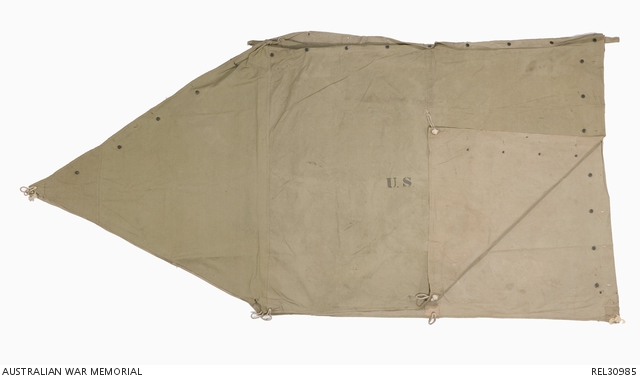| Places | |
|---|---|
| Accession Number | REL30985 |
| Collection type | Heraldry |
| Object type | Personal Equipment |
| Physical description | Brass, Canvas |
| Maker |
Langdon Tent & Awning Co |
| Place made | United States of America |
| Date made | 1942 |
| Conflict |
Second World War, 1939-1945 |
US Army issue personal shelter : Private J M Bruce, 2/16 Battalion, AIF

Pair of khaki canvas US Army personal shelters (Tent, Shelter, Half, sometimes referred to as a 'Pup Tent') which assemble into a complete Tent, Shelter, for two men. Each half is a rectangular sheet of canvas with a triangular section at one end. (A later version, which superceded this one, featured the triangular section at each end.) A series of brass buttons and eyelets along the top edge of each sheet enables the two to be buttoned together with a 14 cm overlap forming a water resistant join. The two triangular sections can be buttoned together in a similar fashion, the opposite end of the shelter remaining open. A series of 3 reinforced brass eyelets along the bottom edge of each sheet, and one at the point of each triangle, hold footing ropes, enabling the shelter to be pegged to the ground. Each of the halves is stencilled 'U.S.' in black paint, and the words 'THE LANGDON TENT & AWNING CO. MANUFACTURED IN 1942' are stamped in black on the external lower edge. For use in service, each shelter half would have also have been accompanied by 1 guy rope, 5 wooden pegs and 4 poles.
Two halves of a khaki canvas US Army personal shelter issued to Private NX111315 James Meikle Bruce, 2/16 Battalion, AIF. Bruce was born in 1923 and attempted to enlist in the RAAF during the Second World War. Having passed a medical examination for aircrew, he was recalled to Militia service and volunteered for the AIF. After a period spent serving as an NCO with an armoured unit at Singleton, he was remustered into the infantry, eventually joining 2/16 Battalion, with whom he served as a private in Borneo and the Celebes. Post-war, Bruce joined the CMF as a private in 1948, but was commissioned as a lieutenant (in the Australian Army Service Corps) the following year. He left the force in 1951. The US Army personal shelters, which were designed so that two men, each carrying one half, could combine their sections to form a small tent, were on issue to Australian forces in the South West Pacific from 1944.
Share this page
Related information
Conflicts
Subjects
People
Related Objects
- Australian Army officer's winter service dress tunic : Lieutenant J M Bruce, RAASC
- Australian Army officer's winter service dress trousers : Lieutenant J M Bruce, RAASC
- Pattern 1937 Haversack : Private J M Bruce, 2/16 Battalion, AIF
- Pattern 1937 Pack : Private J M Bruce, 2/16 Battalion, AIF
- Kitbag : Private J M Bruce, 2/16 Battalion, AIF